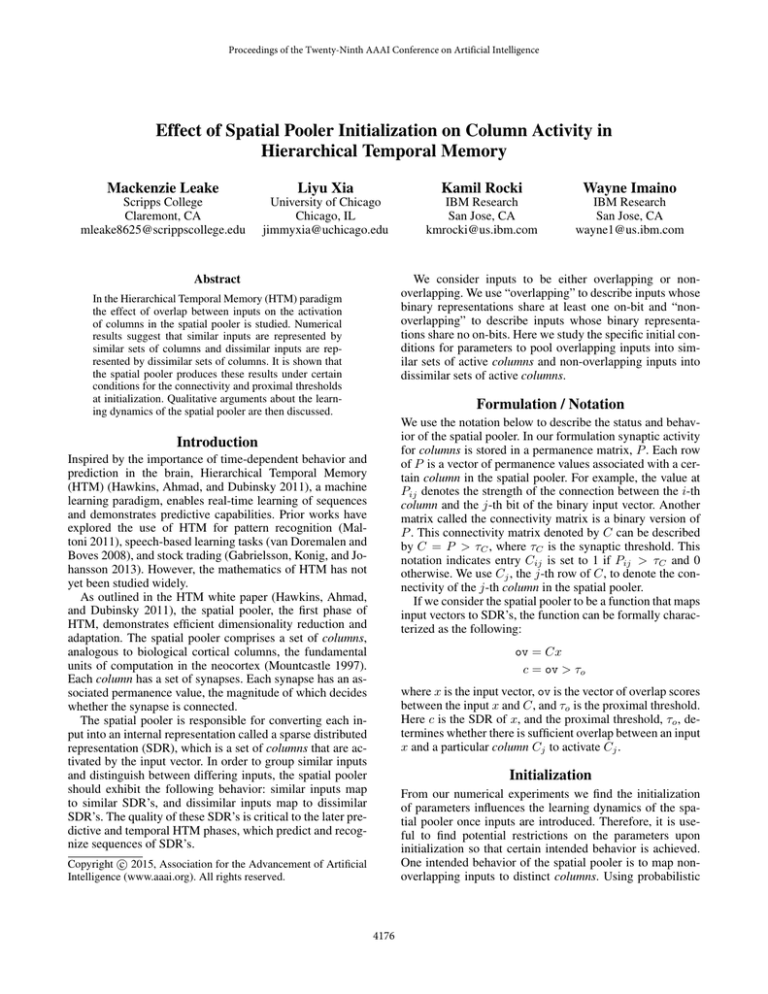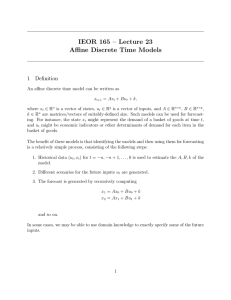
Proceedings of the Twenty-Ninth AAAI Conference on Artificial Intelligence
Effect of Spatial Pooler Initialization on Column Activity in
Hierarchical Temporal Memory
Mackenzie Leake
Liyu Xia
Kamil Rocki
Wayne Imaino
Scripps College
Claremont, CA
mleake8625@scrippscollege.edu
University of Chicago
Chicago, IL
jimmyxia@uchicago.edu
IBM Research
San Jose, CA
kmrocki@us.ibm.com
IBM Research
San Jose, CA
wayne1@us.ibm.com
Abstract
We consider inputs to be either overlapping or nonoverlapping. We use “overlapping” to describe inputs whose
binary representations share at least one on-bit and “nonoverlapping” to describe inputs whose binary representations share no on-bits. Here we study the specific initial conditions for parameters to pool overlapping inputs into similar sets of active columns and non-overlapping inputs into
dissimilar sets of active columns.
In the Hierarchical Temporal Memory (HTM) paradigm
the effect of overlap between inputs on the activation
of columns in the spatial pooler is studied. Numerical
results suggest that similar inputs are represented by
similar sets of columns and dissimilar inputs are represented by dissimilar sets of columns. It is shown that
the spatial pooler produces these results under certain
conditions for the connectivity and proximal thresholds
at initialization. Qualitative arguments about the learning dynamics of the spatial pooler are then discussed.
Formulation / Notation
We use the notation below to describe the status and behavior of the spatial pooler. In our formulation synaptic activity
for columns is stored in a permanence matrix, P . Each row
of P is a vector of permanence values associated with a certain column in the spatial pooler. For example, the value at
Pij denotes the strength of the connection between the i-th
column and the j-th bit of the binary input vector. Another
matrix called the connectivity matrix is a binary version of
P . This connectivity matrix denoted by C can be described
by C = P > τC , where τC is the synaptic threshold. This
notation indicates entry Cij is set to 1 if Pij > τC and 0
otherwise. We use Cj , the j-th row of C, to denote the connectivity of the j-th column in the spatial pooler.
If we consider the spatial pooler to be a function that maps
input vectors to SDR’s, the function can be formally characterized as the following:
Introduction
Inspired by the importance of time-dependent behavior and
prediction in the brain, Hierarchical Temporal Memory
(HTM) (Hawkins, Ahmad, and Dubinsky 2011), a machine
learning paradigm, enables real-time learning of sequences
and demonstrates predictive capabilities. Prior works have
explored the use of HTM for pattern recognition (Maltoni 2011), speech-based learning tasks (van Doremalen and
Boves 2008), and stock trading (Gabrielsson, Konig, and Johansson 2013). However, the mathematics of HTM has not
yet been studied widely.
As outlined in the HTM white paper (Hawkins, Ahmad,
and Dubinsky 2011), the spatial pooler, the first phase of
HTM, demonstrates efficient dimensionality reduction and
adaptation. The spatial pooler comprises a set of columns,
analogous to biological cortical columns, the fundamental
units of computation in the neocortex (Mountcastle 1997).
Each column has a set of synapses. Each synapse has an associated permanence value, the magnitude of which decides
whether the synapse is connected.
The spatial pooler is responsible for converting each input into an internal representation called a sparse distributed
representation (SDR), which is a set of columns that are activated by the input vector. In order to group similar inputs
and distinguish between differing inputs, the spatial pooler
should exhibit the following behavior: similar inputs map
to similar SDR’s, and dissimilar inputs map to dissimilar
SDR’s. The quality of these SDR’s is critical to the later predictive and temporal HTM phases, which predict and recognize sequences of SDR’s.
ov = Cx
c = ov > τo
where x is the input vector, ov is the vector of overlap scores
between the input x and C, and τo is the proximal threshold.
Here c is the SDR of x, and the proximal threshold, τo , determines whether there is sufficient overlap between an input
x and a particular column Cj to activate Cj .
Initialization
From our numerical experiments we find the initialization
of parameters influences the learning dynamics of the spatial pooler once inputs are introduced. Therefore, it is useful to find potential restrictions on the parameters upon
initialization so that certain intended behavior is achieved.
One intended behavior of the spatial pooler is to map nonoverlapping inputs to distinct columns. Using probabilistic
c 2015, Association for the Advancement of Artificial
Copyright Intelligence (www.aaai.org). All rights reserved.
4176
methods we can derive a relationship between the connectivity threshold, τC , the proximal threshold, τo , and the number
of on-bits, d, in the input vector.
Assume we have two non-overlapping inputs, xa and xb .
Assume xa activates column Cj , i.e. ovac is greater than τo ,
and assume all inputs are equally likely. Without loss of generality, we assume xa = [1, . . . , 1, 0, . . . , 0]. Denote these
assumptions as event Z. Using the linearity of expectation,
we compute the expected value, En , for the overlap between
xb and Cj given Z. This gives:
En = E[
L
X
k=1
=
L
X
xbk Cjk |Z] =
L
X
input activates a distinct column, we claim this behavior
will continue during the learning phase. Suppose input xa
activates column Cj and no other input activates Cj initially. Once learning starts, xa will readily activate Cj , and
ovac will increase incrementally. However, another nonoverlapping input xb will not activate Cj . Thus, xa will continue to activate Cj during the learning phase, while all other
inputs will have no effect on Cj . We can extend this reasoning to all other non-overlapping inputs and columns to ensure non-overlapping inputs activate distinct columns.
We can also make qualitative arguments about the behavior of overlapping inputs during the learning phase. Let us
examine a specific example for two overlapping inputs. Suppose we have two inputs, xa and xb , which have sufficient
overlap to activate the same column Cj , and suppose the values of P corresponding to this column are not so close to the
connectivity threshold, τC , that one update of P will result
in a change of C. If xa and xb are the only inputs and they
are presented to the spatial pooler the same number of times
in an alternating fashion, Cj will reinforce the common parts
of xa and xb . During learning when xa activates Cj , the entries in P that are associated with Cj and correspond to the
on-bits in xa will be incremented, while the entries of P that
are associated with Cj and are unique to xb will be decremented. Similar changes in P will occur when xb activates
Cj . The entries of P corresponding to the shared on-bits of
xa and xb will be incremented twice, while the entries of P
associated with the on-bits that are unique to either xa or xb
will be incremented for one input and decremented for the
other. This results in the reinforcement of the common parts
of xa and xb . Under these assumptions we see a mechanism
for how the spatial pooler groups similar inputs.
P[xbk = 1, Cjk = 1|Z]
k=1
P[xbk = 1, Cjk = 1|Z].
k=d+1
Using Bayes’ theorem we compute:
En =
L
X
P[xbk = 1|Cjk = 1, Z] × P[Cjk = 1|Z].
k=d+1
Considering all possible xb , the probability for each entry of
d
resulting in:
xb to be 1 is L−d
En =
L
X
k=d+1
d
× P[Cjk = 1|Z] = d × P[Cjk = 1|Z].
L−d
The threshold for connectivity is τC so the expected number
of 1’s within a row of the connectivity matrix is L(1 − τC ).
The number of 1’s in the first d entries of column Cj is
equal to ovac because we assumed xa = [1, . . . , 1, 0, . . . , 0].
Therefore, the number of 1’s left for column Cj to overlap
with xb is equal to L(1 − τC ) − ovac . This results in:
Summary
We show that with careful initialization of parameters the
spatial pooler maps distinct inputs into distinct SDR’s as
indicated by the column activity. Assuming appropriate parameter selection, we make observations about the learning
dynamics for both non-overlapping and overlapping inputs.
L(1 − τC ) − ovac
.
En = d ×
L−d
The proximal threshold τo can provide a loose upper bound
for En to ensure on average xb will not activate Cj . We can
substitute ovac by τo , since xb should not activate Cj as long
as xa activates Cj . We then find:
References
Gabrielsson, P.; Konig, R.; and Johansson, U. 2013. Evolving hierarchical temporal memory-based trading models. In
EvoApplications 2013, 213–222.
Hawkins, J.; Ahmad, S.; and Dubinsky, D. 2011. Hierarchical temporal memory including HTM cortical learning algorithms. Technical Report 0.2.1, Numenta, Redwood City,
Calif.
Maltoni, D. 2011. Pattern recognition by hierarchical temporal memory. Technical report, DEIS Univ. of Bologna.
Mountcastle, V. 1997. The columnar organization of the
neocortex. Brain 120(4):701–722.
van Doremalen, J., and Boves, L. 2008. Spoken digit recognition using a hierarchical temporal memory. In Interspeech,
2566–2569.
L(1 − τC ) − τo
d×
≤ τo
L−d
1
1 − τC ≤ τo .
d
This preceding relationship provides guidelines for the initialization of τC and τo that on average will prohibit input
xb from activating column Cj . We can also perform a similar analysis for two overlapping inputs to obtain numerical
relationships between parameters upon initialization.
Incremental learning
Moving beyond the initialization phase, we can make observations about the interaction between non-overlapping inputs and the spatial pooler during the learning phase. If the
parameters are initialized such that each non-overlapping
4177








